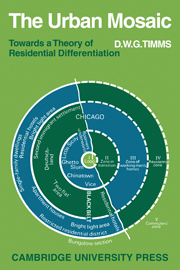Book contents
2 - Ecological structure and factor structure
Published online by Cambridge University Press: 05 January 2012
Summary
The neighbourhoods which comprise the residential fabric of the city and form the framework for analyses of the relationship between locality and behaviour differ on innumerable grounds. In terms of physical structure they differ in density and age of development, in geographical position, and in types of dwellings. More importantly, from a behavioural perspective, their populations differ in age and sex composition, in occupations, incomes, and styles of life, in political, ethnic, and religious allegiances, and in a wide range of attitudes and behaviours. Each of these differences contributes its portion to the patterning of the urban residential system. In any attempt to understand this system it is necessary that each of these diverse differences should in some way be taken into account. The measurement problems which this involves form the major preoccupation of the present chapter.
UNIVERSES OF CONTENT, INDICANTS AND PROPERTIES
The conceptual tools which form the basic instruments of scientific endeavour may be classified under many rubrics. For our present purposes it is only necessary to distinguish between three such constructs: universes of content, indicants, and properties. In combination these three provide the basic tools for measurement and classification.
The universe of content
The universe of content forms the subject-matter of an analysis. It consists of the set of elements to which the procedures of measurement or classification are to be applied.
Information
- Type
- Chapter
- Information
- The Urban MosaicTowards a Theory of Residential Differentiation, pp. 36 - 84Publisher: Cambridge University PressPrint publication year: 1971
